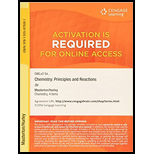
Use the following half-equations to write three spontaneous reactions. Justify your answers by calculating E° for the cells.
1.
2.
3.
Interpretation:
Using the given half-equations, the three spontaneous reactions needs to be determined by showing the value E° for the cells.
Concept introduction:
A reducing or a reductant is a species that loses electron/s and gets oxidized in the chemical reaction. The reducing agent is usually in one of its lower probable oxidation states, is recognized as the electron donor. Since, the reducing agent in the redox reaction loses electron/s, reducing agent gets oxidized.
An oxidizing agent is an agent which gains the electrons and get reduced within the chemical reaction. It is also recognized as electron acceptor; it is usually in one of its higher probable oxidation states so that it can reduce after accepting electron/s.
Spontaneity of a reaction is dependent on the free energy sign that is
Since,
Here, n = number of electrons involved in reaction and F is faraday constant.
If the value of E° for a reaction is positive, then the reaction occurs spontaneous.
Answer to Problem 39QAP
The three spontaneous reactions are as follows:
(a)
(b)
(c)
Explanation of Solution
Given Information:
The three half-equations are given as follows:
Suppose cell consisting half-equation (2) as oxidation half-reaction and half-equation (1) as reduction half-reaction.
Balancing the electrons in above two reaction and then adding the two equations to get overall cell reaction.
The value of E° for a cell is the sum of standard reduction as well as standard oxidation potentials.
Since, the value of E° for the cell is positive, the overall cell reaction is spontaneous.
Suppose cell consisting half-equation (3) as oxidation half-reaction and half-equation (1) as reduction half-reaction.
Balancing the electrons in above two reaction and then adding the two equations to get overall cell reaction.
The value of E° for a cell is the sum of standard reduction as well as standard oxidation potentials.
Since, the value of E° for the cell is positive, the overall cell reaction is spontaneous.
Suppose cell consisting half-equation (3) as oxidation half-reaction and half-equation (1) as reduction half-reaction.
Balancing the electrons in above two reaction and then adding the two equations to get overall cell reaction.
The value of E° for a cell is the sum of standard reduction as well as standard oxidation potentials.
Since, the value of E° for the cell is positive, the overall cell reaction is spontaneous.
Thus, the three spontaneous reactions will be:
(a)
(b)
(c)
Want to see more full solutions like this?
Chapter 17 Solutions
Owlv2, 4 Terms (24 Months) Printed Access Card For Masterton/hurley's Chemistry: Principles And Reactions, 8th
- Another type of battery is the alkaline zinc-mercury cell, in which the cell reaction is Zn(s) + HgO(s) Hg() + ZnO(s) E = + 1.35 V (a) What is the standard free energy change for this reaction? (b) The standard free energy change in a voltaic cell is the maximum electrical energy that the cell can produce. If the reaction in a zinc-mercury cell consumes 1.00 g mercury oxide, what is the standard free energy change? (c) For how many hours could a mercury cell produce a 10-mA current if the limiting reactant is 3.50 g mercury oxide?arrow_forwardYou have 1.0 M solutions of Al(NO3)3 and AgNO3 along with Al and Ag electrodes to construct a voltaic cell. The salt bridge contains a saturated solution of KCl. Complete the picture associated with this problem by a writing the symbols of the elements and ions in the appropriate areas (both solutions and electrodes). b identifying the anode and cathode. c indicating the direction of electron flow through the external circuit. d indicating the cell potential (assume standard conditions, with no current flowing). e writing the appropriate half-reaction under each of the containers. f indicating the direction of ion flow in the salt bridge. g identifying the species undergoing oxidation and reduction. h writing the balanced overall reaction for the cell.arrow_forwardFour voltaic cells are set up. In each, one half-cell contains a standard hydrogen electrode. The second half-cell is one of the following: (i) Cr3+(aq, 1.0 M)|Cr(s) (ii) Fea+(aq, 1.0M)|Fe(s) (iii) Cu2+(aq, 1.0M)|Cu(s) (iv) Mg2+(aq, 1.0M)|Mg(s) (a) In which of the voltaic cells does the hydrogen electrode serve as the cathode? (b) Which voltaic cell produces the highest potential? Which produces the lowest potential?arrow_forward
- The half cells Sn2+(aq) |Sn(s) and Cl2(g) |Cl(aq) are linked to create a voltaic cell. (a) Write equations for the oxidation and reduction half-reactions and for the overall (cell) reaction. (b) Which half-reaction occurs in the anode compartment, and which occurs in the cathode compartment? (c) Complete the following sentences: Electrons in the external circuit flow from the ______ electrode to the ____ electrode. Negative ions move in the salt bridge from the _____ half-cell to the _____ half-cell.arrow_forwardCalculate the standard cell potential of the cell corresponding to the oxidation of oxalic acid, H2C2O4, by permanganate ion. MnO4. 5H2C2O4(aq)+2MnO4(aq)+6H+(aq)10CO2(g)+2Mn2+(aq)+8H2O(l) See Appendix C for free energies of formation: Gf for H2C2O4(aq) is 698 kJ.arrow_forward
 Chemistry: An Atoms First ApproachChemistryISBN:9781305079243Author:Steven S. Zumdahl, Susan A. ZumdahlPublisher:Cengage Learning
Chemistry: An Atoms First ApproachChemistryISBN:9781305079243Author:Steven S. Zumdahl, Susan A. ZumdahlPublisher:Cengage Learning Chemistry: The Molecular ScienceChemistryISBN:9781285199047Author:John W. Moore, Conrad L. StanitskiPublisher:Cengage Learning
Chemistry: The Molecular ScienceChemistryISBN:9781285199047Author:John W. Moore, Conrad L. StanitskiPublisher:Cengage Learning Chemistry & Chemical ReactivityChemistryISBN:9781133949640Author:John C. Kotz, Paul M. Treichel, John Townsend, David TreichelPublisher:Cengage Learning
Chemistry & Chemical ReactivityChemistryISBN:9781133949640Author:John C. Kotz, Paul M. Treichel, John Townsend, David TreichelPublisher:Cengage Learning Chemistry: Principles and PracticeChemistryISBN:9780534420123Author:Daniel L. Reger, Scott R. Goode, David W. Ball, Edward MercerPublisher:Cengage Learning
Chemistry: Principles and PracticeChemistryISBN:9780534420123Author:Daniel L. Reger, Scott R. Goode, David W. Ball, Edward MercerPublisher:Cengage Learning Chemistry & Chemical ReactivityChemistryISBN:9781337399074Author:John C. Kotz, Paul M. Treichel, John Townsend, David TreichelPublisher:Cengage Learning
Chemistry & Chemical ReactivityChemistryISBN:9781337399074Author:John C. Kotz, Paul M. Treichel, John Townsend, David TreichelPublisher:Cengage Learning





